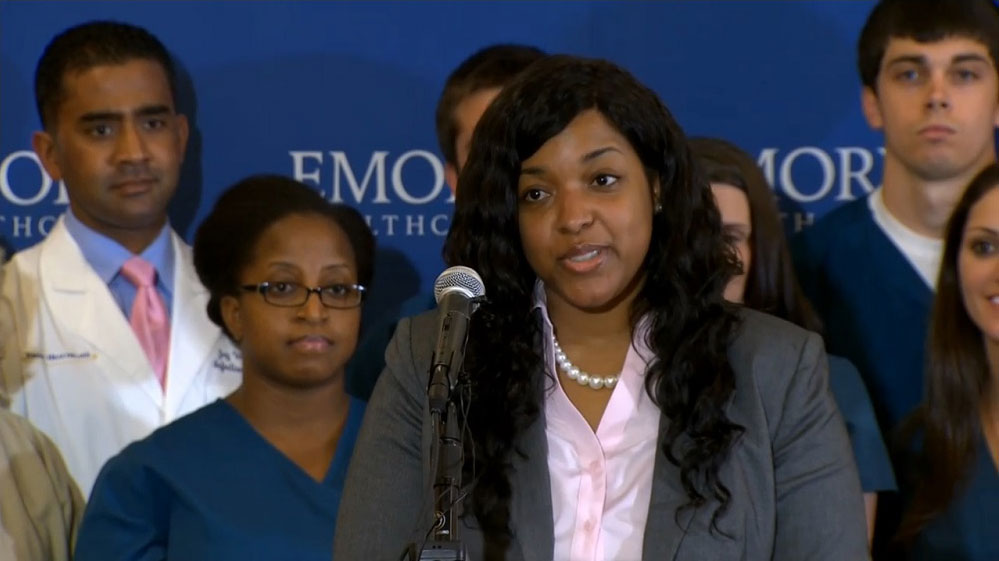Ebola Recovery: How Did Dallas Nurses Get Well So Quickly?

The two nurses in Dallas who became infected with Ebola this month may have recovered so quickly because of their youth, as well as the protective equipment they were wearing at the time of infection, according to a doctor who has treated Ebola patients.
Today (Oct. 28), nurse Amber Vinson, who was infected with Ebola earlier this month, was declared free of the virus, and was released from Emory University Hospital in Atlanta, where she was treated.
"I'm so grateful to be well," Vinson said at a news conference this afternoon. "While the skill and dedication of the doctors, nurses and others who have taken care of me have obviously led to my recovery, it has been God's love that has truly carried my family and me through this difficult time." [How Do People Survive Ebola?]
After thorough testing, "we have determined that Ms. Vinson has recovered from her infection with Ebola virus, and that she can return to her family, to the community and to her life, without any concerns about transmitting this virus to any other individuals," said Dr. Bruce Ribner, director of the Serious Communicable Disease Unit at Emory University Hospital.
Vinson's release comes less than a week after Nina Pham, a nurse who works with Vinson and was also infected with Ebola, was declared free of the virus and well enough to go home.
Ribner said that doctors are not entirely sure why the two nurses recovered so quickly. (Both developed their first symptoms about two weeks ago.) But he noted that they are two of the youngest patients to be treated for Ebola in developed countries — Vinson is 29, and Pham is 26.
"We know that younger patients do much better," Ribner said.
Sign up for the Live Science daily newsletter now
Get the world’s most fascinating discoveries delivered straight to your inbox.
The first two Americans to develop Ebola, Dr. Kent Brantly and nurse Nancy Writebol, were infected in West Africa and were flown back to the U.S. to also be treated at Emory. Brantly, who is 33, was released from the hospital about a month after he developed symptoms, and Writebol, age 59, was released about five weeks after she developed symptoms.
In addition, because they were wearing personal protective equipment when they were treating an Ebola patient, the nurses were likely exposed to a low level of the virus.
"It's quite likely that the amount of virus that [Vinson] was exposed to was substantially less than what we see in patients who get infected in less-developed countries," Ribner said. "The higher the viral load that you get infected with, the more severe your disease is likely to be."
Emory University has now successfully treated four Ebola patients.
Vinson and Pham became infected with Ebola when they cared for Thomas Eric Duncan, the first person to be diagnosed with Ebola in the United States.
It's still not clear how the nurses became infected with the virus. However, some people have questioned the original guidelines from the Centers for Disease Control and Prevention on how to use personal protective equipment when treating Ebola patients. The agency announced on Oct. 20 that it had updated those guidelines to better protect workers.
Health care workers are at higher risk than the general public for Ebola infection because they often treat patients who have reached the stage of the infection with the most symptoms and the highest viral load in their bodily fluids.
Follow Rachael Rettner @RachaelRettner. Follow Live Science @livescience, Facebook & Google+. Original article on Live Science.

Rachael is a Live Science contributor, and was a former channel editor and senior writer for Live Science between 2010 and 2022. She has a master's degree in journalism from New York University's Science, Health and Environmental Reporting Program. She also holds a B.S. in molecular biology and an M.S. in biology from the University of California, San Diego. Her work has appeared in Scienceline, The Washington Post and Scientific American.










